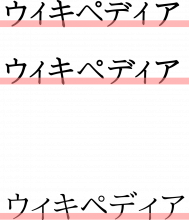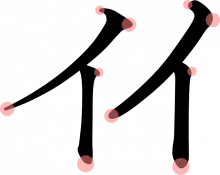To my eyes, the baseline of the Wikipedia text logo in the Japanese mobile website looks slightly off - not straight enough. The logo is shown at the top of https://ja.m.wikipedia.org/ .
To illustrate the problem, I created a comparison: 1 (current logo, unmodified), 2 (current logo, adjusted by me), 3 (plain render of the same word in Takao Mincho with no adjustment). Notice (the lack of) the gap beneath ィ in particular.
This is not to say that all characters in Japanese must be aligned at the bottom, nor any creative placement is impossible. I'd like to know if there is a specific reason why the characters were placed the way they are, however.
I believe the target file is at operations/mediawiki-config/static/images/mobile/copyright/wikipedia-wordmark-ja.svg .




